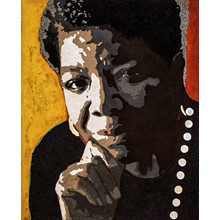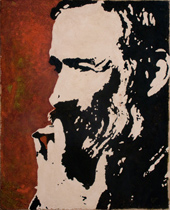![]()
|
||||||||
| PEOPLE | |||
|---|---|---|---|
|
|
|||
| Is there still any sense in painting the human figure and in particular portraits? In my youth, during visits to the National Museum of Naples, Pompeian frescoes always fascinated me. Looking at these ancient paintings I got that special feeling of wonder and amazement that for ancient Greeks was the beginning of learning. At that time, my knowledge of old heroes and their stories was very shallow thus allowing me, to a certain extent, to look at the form without its interpretation. My sight wandered across the painted surfaces being absorbed, from time to time, by some forms or patterns of colors or by small fragments of terracotta or glass tesseras mixed into the lime mortar. It seems to me that the opaque surface of fresco painting is, somehow, attracting my sight to enter inside it and through this intrinsic and determining character, fresco painting, while holding our attention on itself, shows and defines itself as something that cannot be “said”, cannot be reformulated without being lost or transformed into some kind of other.
|
 Maya Angelou |
||
In the last century, the focus of art shifted from illusionist representation to independent objectivity. The contemporary notion of painting is of an autonomous entity that has no other need than to assert its own existence, with no reference to visible reality. Artworks are built to exist by themselves, with no need to look like or represent any other object. A painting interacts with the sight of the observer and from this dialogue without words is born a non-intellectual awareness. |
 Edgar Morin Edgar Morin |
||
Playing with sand, lime and mineral pigments, the basic elements in the art of fresco painting, I posed myself questions on the essence of color and on the meaning of the very act of painting in contemporary society. |
 Constantin Brancusi |
||
| In Minimal fresco the sand and lime mortar are not used simply as a base but the different varieties are used as colours and textures in themselves, while the distinctive element of materic fresco is the thick layers of pre-coloured mortar, which are applied with a palette knife. Working in this way, the process of building the image becomes the subject of the work as much as the subject represented. Transferring a portrait onto a large format means that the subject is never seen in its totality; the portrait is produced by working on small pieces without seeing the whole image. Difficulties of this kind are crucial to define the nature of the image that will be built up through a process. Renaissance fresco painters solved this problem through the cartoni and spolvero technique (cartoon and pouncing). |
|||
|
|||
The cartoni technique is a procedural one because it gives priority to the process and defines the steps of the work before doing them. |
Rabindranath Tagore |
||
|
|
|||